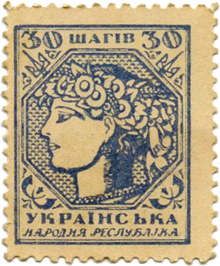This article needs additional citations for verification. (November 2022) |
Shah (Ukrainian: шаг) was the name of several currencies used in Ukraine. The forms shahy (шаги, for 2 to 4) and shahiv (шагiв, for five or more) are declensional plurals of the noun used in denominations, for example, 2 shahy, 20 shahiv.

Etymology
editAccording to etymological studies, the word shah arose from an earlier siah (сяг — “step”; “extent”), which ascends to Proto-Slavic *sęgъ (“length measured with outstretched arms”), formed from *sęgati (“to stretch out the arm”). The same origin is shared with other Ukrainian words like sazhen' (сажень < Old East Slavic: сѧжєнь — “fathom”) and siahaty (сягати — “to touch”; “to reach”).[1][2]
The modern form of the word evolved through assimilation in the diminutive siazhok (сяжок), that had changed to shazhok (шажок), from which shah emerged.[1]
Ukrainian historians believe that the name shah (as well as the diminutive shazhok) refers to “the smallest step when counting money” and is an authentic element of Ukrainian lexical heritage. To this day, the meaning of shah as the smallest amount of money is preserved in the Ukrainian language.[3]
17th–19th centuries
editUkrainian-speakers used the term shah to refer to the Polish–Lithuanian Commonwealth's silver coin of 17th-18th centuries with face value of 3 grosz, coined from 1528, and especially during the times of Sigismund III Vasa (ruled Poland–Lithuania from 1587 to 1632). Later, when the Ukrainian lands came increasingly under the influence of Russia, the name was transferred to the Russian copper coin of 2 kopecks. From 1839, when the Russian Empire extended its silver coinage, the term shah was transferred to the silver ½-kopeck. This term for the kopeck remained in use until 1917.[3]
Early 20th century
editIn 1917, banknotes were introduced in the newly independent Ukraine. These were denominated in shah, hryvnia and karbovanets, with 100 shahiv = 1 hryvnia and 2 hryvni = 1 karbovanets.
At the beginning of the 20th century, during World War I (1914–1918), many countries issued currency in the form of stamps. It was done similarly in early independent Ukrainian states: in West Ukrainian National Republic and Ukrainian People's Republic. There, these money stamps were called shahivky (шагiвки, singular: шагiвка, shahivka). Stamps in denominations of 10, 20, 30, 40, and 50 shahs were issued.[4]
These shahivky were printed on perforated 11 ½ card stock, due to a shortage of metals needed for the war effort at the time. Each currency stamp was inscribed on the reverse with a tryzub (trident) and with some words stating that these shahivky circulate in lieu of coins and that they are prohibited to be used as stamps. However, they do appear on some postal envelopes as there was an acute deficiency of "true" stamps. Nevertheless, on July 18, 1918, the independent Ukrainian government authorized its first set of stamp issues, also called shahivky and having nearly identical designs.
The 10 and 20-shah stamps issues of Ukrainian People's Republic were designed by the artist Anton Sereda and the 30, 40, and 50-shah stamps by Heorhiy Narbut, a master graphic artist and president of the Ukrainian Academy of Arts in Kyiv.
Late 20th–21st centuries
editIn 1992, after the dissolution of the Soviet Union after which the newly independent Ukraine was able to choose its own currency, trial runs of coins of 1 shah and 50 shahiv were issued, but were not approved. Therefore, the kopiyka (копійка) was confirmed as a numismatic term for Ukrainian currency, despite nationalistic sentiments that kopiyka (a cognate of Russian kopeyka) is a Russian term.
On 2 September 2024, the National Bank of Ukraine proposed to rename the kopiyka to the historical shah as a part of the derussification campaign.[5]
See also
edit- Postage stamps and postal history of Ukraine
- Ukrainian hryvnia, the national currency of Ukraine since 1996
- Ukrainian karbovanets, currency of Ukraine during three separate periods
- Economy of Ukraine
References
edit- ^ a b "Шаг". Etymological dictionary of the Ukrainian language [Etymolohichnyy slovnyk ukrayins'koyi movy] (in Ukrainian). Vol. 6. 2012.
- ^ "Сажень". Etymological dictionary of the Ukrainian language [Etymolohichnyy slovnyk ukrayins'koyi movy] (in Ukrainian). Vol. 5. 2006.
- ^ a b Okhrimenko, Tetiana (2019). "FOREIGN WORD AND SLAVIC WORD IN MONETARY NAMES" (pdf). Opera in Linguistica Ukrainiana (in Ukrainian). 1 (26): 77–85. doi:10.18524/2414-0627.2019.26.180953.
- ^ Sholohon, Lilіia (2022-06-15). "PHILATELY AS A SPECIAL HISTORICAL DISCIPLINE (ON THE EXAMPLES PRODUCTION AND USE OF STAMPS DURING THE UKRAINIAN REVOLUTION OF 1917–1921)". Grail of Science (14–15): 621–626. doi:10.36074/grail-of-science.27.05.2022.114. ISSN 2710-3056. S2CID 249735013.
- ^ Denysiuk, Mariia (2024-09-02). НБУ пропонує замінити копійки новими монетами під назвою «шаг» [The NBU proposes to change kopiikas with new coins called shahs]. Forbes.ua.
External links
edit- Chernoivanenko, Vitaliy. History of paper money in Ukraine (1917–1920) in Zerkalo Nedeli, September 22–28, 2001. Available in Russian and Ukrainian
- History of Ukrainian money in Zerkalo Nedeli, September 2–8, 2006. Available in Russian and Ukrainian